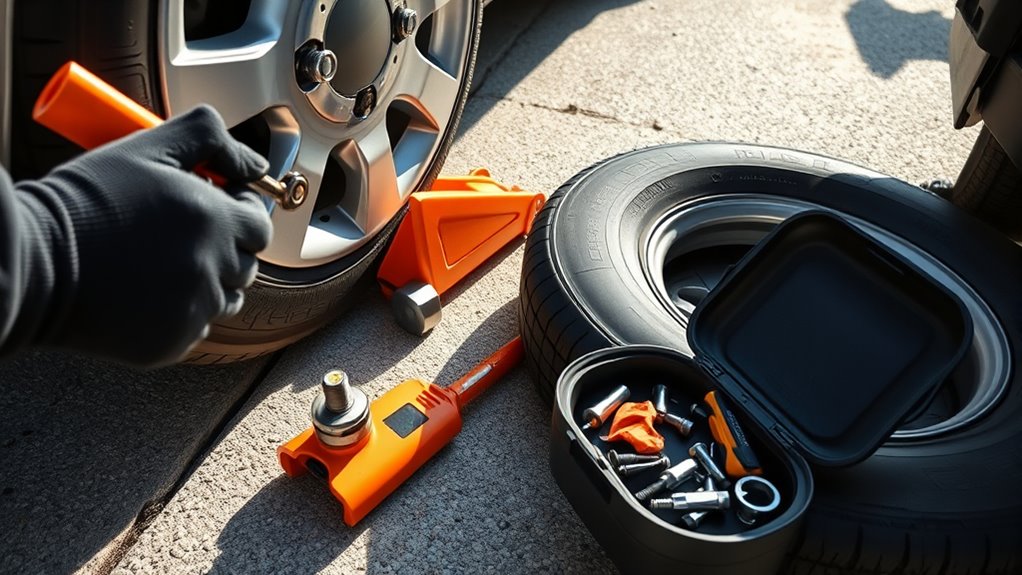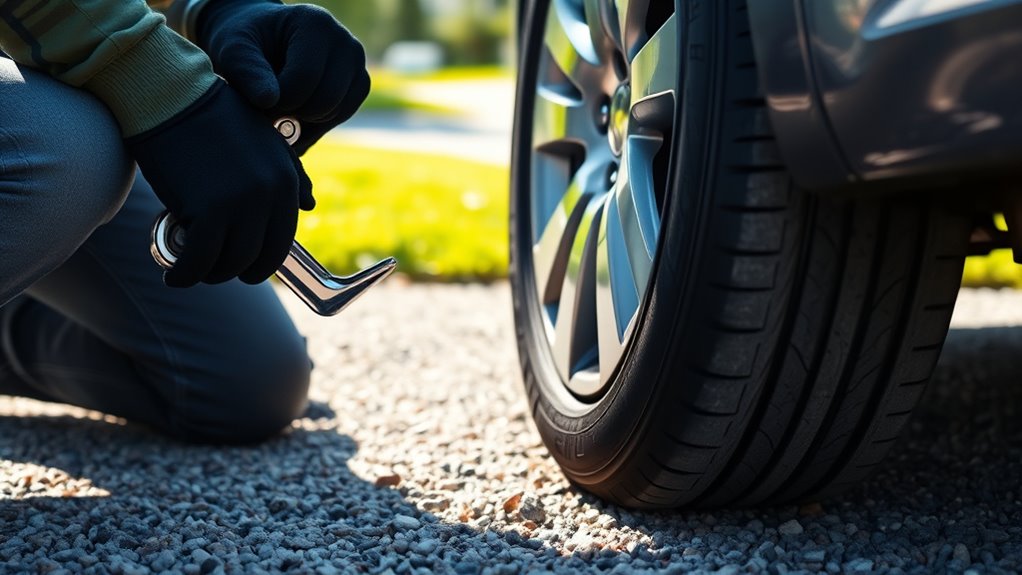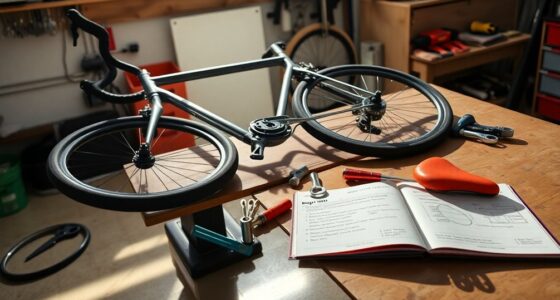If you get a flat tire, stay calm and find a safe place to pull over. Turn on your hazard lights and loosen the lug nuts slightly while the tire is still on the ground. Use a jack to lift the car, then remove the flat tire and replace it with a spare. Tighten the lug nuts in a star pattern, lower the vehicle, and double-check everything. To learn all the essential steps, keep exploring the detailed process.
Key Takeaways
- Ensure safety by pulling over, turning on hazard lights, and setting the parking brake before starting.
- Loosen lug nuts slightly while the tire is on the ground to prepare for removal.
- Use a jack at the recommended point to lift the vehicle until the flat tire is off the ground.
- Remove the flat tire, replace it with the spare, and hand-tighten the lug nuts.
- Lower the vehicle, then tighten lug nuts in a star pattern, check tire pressure, and secure all tools.

Getting a flat tire can be stressful, but knowing how to fix it quickly can save you time and trouble. The first step is to stay calm and assure your safety. If you’re on the road, pull over to a safe spot away from traffic, turn on your hazard lights, and set your parking brake. Once you’re in a secure position, gather your tools—typically a spare tire, a jack, a lug wrench, and possibly a tire pressure gauge and gloves. If you don’t have these, consider keeping a basic roadside kit in your vehicle.
Stay calm, pull over safely, turn on hazard lights, and gather your essential tools.
Next, loosen the lug nuts before lifting the car. Use the lug wrench to turn each nut counterclockwise a few turns, but don’t remove them completely yet. Loosening them while the tire is still on the ground provides stability. If the nuts are tight, applying steady pressure and using your body weight can help. Once the nuts are loosened, place the jack under the vehicle’s recommended jacking point—usually marked in your owner’s manual—and raise the car until the flat tire is just clear of the ground. Be sure to lift the vehicle high enough so that the spare tire can be mounted comfortably.
With the car elevated, completely unscrew the lug nuts and set them aside in a safe spot. Carefully remove the flat tire by pulling straight toward you, then place it under the vehicle near the jack point as a backup in case the jack slips. Take the spare tire and align it with the lug bolts, then slide it onto the hub. Hand-tighten the lug nuts onto the bolts as much as possible to secure the tire in place. Lower the vehicle slowly until the tire just touches the ground, then tighten the lug nuts in a star pattern—tightening each nut a little at a time to guarantee even pressure. Once the vehicle is fully on the ground, do a final tightening of all lug nuts.
Afterward, double-check the pressure of your spare tire, especially if it’s a temporary space-saver, which often requires higher pressure. Put away your tools and the damaged tire, and make sure everything is secure. Remember, a spare tire isn’t meant for long distances or high speeds, so get your regular tire repaired or replaced as soon as possible. Knowing these steps helps you handle a flat efficiently, so you stay safe and get back on the road quickly.
Frequently Asked Questions
Can I Repair a Tire With a Large Puncture?
If you have a large puncture, repairing the tire might not be safe or effective. You could attempt a patch or plug if the damage is on the tread and not too close to the sidewall. However, for bigger holes or sidewall damage, it’s best to replace the tire entirely. Ignoring this could lead to further damage or a blowout, so prioritize safety and consult a professional if unsure.
Is It Safe to Drive on a Flat Tire Temporarily?
Driving on a flat tire might seem tempting, but it’s perilous and potentially damaging. You might think it’s a quick fix, but it’s dangerous and could cause more costly repairs. Instead, pull over promptly, prioritize safety, and prepare to replace or repair the tire. Remember, risking a ride on a deflated tire can lead to disastrous damage, so always choose safety over speed when dealing with a flat.
What Tools Are Essential for Fixing a Flat Tire?
When fixing a flat tire, you need a few essential tools. Keep a spare tire, a jack, and a lug wrench in your car at all times. A tire pressure gauge helps make certain proper inflation, and gloves protect your hands. If you have a tire sealant, it can be a quick fix. Having these tools ready makes the process smoother and safer, especially during emergencies.
How Long Does a Typical Tire Repair Take?
A typical tire repair usually takes around 30 minutes, but it depends on your experience and the tools you have. You’ll need to remove the tire, locate the puncture, and patch or plug it. If you’re well-prepared and follow the steps carefully, you can get back on the road faster. Keep in mind, more complex issues or delays with tools might extend the process.
Should I Replace the Tire if It’S Been Repaired?
Think of your tire as a trusted friend; if it’s been repaired, you need to decide if it’s still reliable. Generally, if the repair is professional and the damage was minor, you can continue using it. However, if the tire has multiple repairs or severe damage, replacing it is safer. Trust your judgment and the repair quality—better to be cautious than risk a blowout later.
Conclusion
Remember, fixing a flat tire is like restoring a lost song—you hold the key to harmony. Each step you take is a note, each tool a melody guiding you back on track. With patience and confidence, you turn a sudden stop into a new rhythm, a fresh start. So, embrace the process, trust your hands, and let your resolve be the steady beat that brings you smoothly back to the road ahead.









